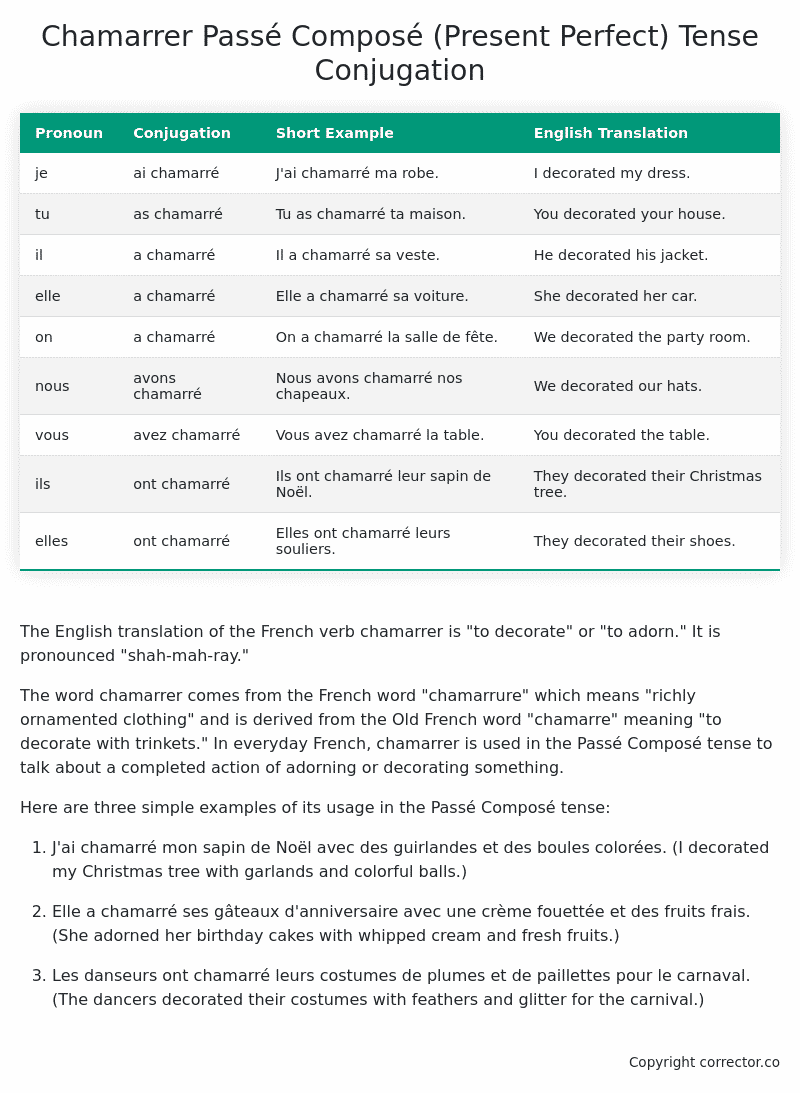Passé Composé (Present Perfect) Tense Conjugation of the French Verb chamarrer
Introduction to the verb chamarrer
The English translation of the French verb chamarrer is “to decorate” or “to adorn.” It is pronounced “shah-mah-ray.”
The word chamarrer comes from the French word “chamarrure” which means “richly ornamented clothing” and is derived from the Old French word “chamarre” meaning “to decorate with trinkets.” In everyday French, chamarrer is used in the Passé Composé tense to talk about a completed action of adorning or decorating something.
Here are three simple examples of its usage in the Passé Composé tense:
-
J’ai chamarré mon sapin de Noël avec des guirlandes et des boules colorées. (I decorated my Christmas tree with garlands and colorful balls.)
-
Elle a chamarré ses gâteaux d’anniversaire avec une crème fouettée et des fruits frais. (She adorned her birthday cakes with whipped cream and fresh fruits.)
-
Les danseurs ont chamarré leurs costumes de plumes et de paillettes pour le carnaval. (The dancers decorated their costumes with feathers and glitter for the carnival.)
Table of the Passé Composé (Present Perfect) Tense Conjugation of chamarrer
| Pronoun | Conjugation | Short Example | English Translation |
|---|---|---|---|
| je | ai chamarré | J’ai chamarré ma robe. | I decorated my dress. |
| tu | as chamarré | Tu as chamarré ta maison. | You decorated your house. |
| il | a chamarré | Il a chamarré sa veste. | He decorated his jacket. |
| elle | a chamarré | Elle a chamarré sa voiture. | She decorated her car. |
| on | a chamarré | On a chamarré la salle de fête. | We decorated the party room. |
| nous | avons chamarré | Nous avons chamarré nos chapeaux. | We decorated our hats. |
| vous | avez chamarré | Vous avez chamarré la table. | You decorated the table. |
| ils | ont chamarré | Ils ont chamarré leur sapin de Noël. | They decorated their Christmas tree. |
| elles | ont chamarré | Elles ont chamarré leurs souliers. | They decorated their shoes. |
Other Conjugations for Chamarrer.
Le Present (Present Tense) Conjugation of the French Verb chamarrer
Imparfait (Imperfect) Tense Conjugation of the French Verb chamarrer
Passé Simple (Simple Past) Tense Conjugation of the French Verb chamarrer
Passé Composé (Present Perfect) Tense Conjugation of the French Verb chamarrer (this article)
Futur Simple (Simple Future) Tense Conjugation of the French Verb chamarrer
Futur Proche (Near Future) Tense Conjugation of the French Verb chamarrer
Plus-que-parfait (Pluperfect) Tense Conjugation of the French Verb chamarrer
Passé Antérieur (Past Anterior) Tense Conjugation of the French Verb chamarrer
Futur Antérieur (Future Anterior) Tense Conjugation of the French Verb chamarrer
Subjonctif Présent (Subjunctive Present) Tense Conjugation of the French Verb chamarrer
Subjonctif Passé (Subjunctive Past) Tense Conjugation of the French Verb chamarrer
Subjonctif Imparfait (Subjunctive Imperfect) Tense Conjugation of the French Verb chamarrer
Subjonctif Plus-que-parfait (Subjunctive Pluperfect) Tense Conjugation of the French Verb chamarrer
Conditionnel Présent (Conditional Present) Tense Conjugation of the French Verb chamarrer
Conditionnel Passé (Conditional Past) Tense Conjugation of the French Verb chamarrer
L’impératif Présent (Imperative Present) Tense Conjugation of the French Verb chamarrer
L’infinitif Présent (Infinitive Present) Tense Conjugation of the French Verb chamarrer
Struggling with French verbs or the language in general? Why not use our free French Grammar Checker – no registration required!
Get a FREE Download Study Sheet of this Conjugation 🔥
Simply right click the image below, click “save image” and get your free reference for the chamarrer present perfect tense conjugation!

Chamarrer – About the French Passé Composé (Present Perfect) Tense
Formation of the Passé Composé
Set the auxiliary verb with either
Conjugate the auxiliary verb
Add the past participle
Common everyday usage patterns
Narrating Past Events
Sequential Actions
Describing Completed Actions
Interactions with other tenses
Imperfect Tense
Conditional and Future Tenses
Summary
I hope you enjoyed this article on the verb chamarrer. Still in a learning mood? Check out another TOTALLY random French verb conjugation!


